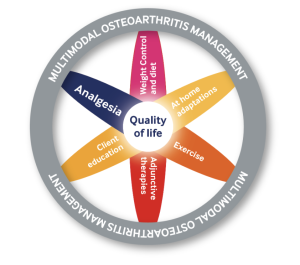DOGS OF ALL AGES COULD BE AFFECTED BY CHRONIC PAIN
Osteoarthritis (OA) should now be recognised as a complex and progressive disease that is not limited to older dogs. Increasingly, evidence shows that OA can also affect younger dogs, including those under the age of one. This shift in understanding means that veterinary professionals must remain alert to the early clinical signs of OA in dogs of all ages. Early diagnosis is critical, as it opens the door to prompt and appropriate management strategies. With timely intervention, the progression of OA can often be slowed, leading to significantly improved clinical outcomes, reduced pain, and a much better overall quality of life for the dog.

A recent study using a structured canine OA screening checklist found that nearly 40% of dogs assessed displayed clinical signs consistent with OA¹. This is a striking figure that highlights how widespread the condition may be, even in the absence of a formal diagnosis. Moreover, research indicates that the overall prevalence of OA exceeds 20% in dogs over the age of just one year², challenging the outdated belief that OA is primarily a concern for elderly pets.
Perhaps even more concerning is the growing recognition that chronic OA-related pain is not uncommon in the young dog population³. Despite this, OA remains underdiagnosed and undertreated in general practice³. As our understanding of the disease evolves, it is becoming increasingly clear that OA is not merely a problem confined to the joints. It is a condition that can affect the entire body, including the dog’s overall wellbeing and psychological state. This, in turn, can have a profound impact on the relationship between the pet and its owner³.
Further highlighting the issue, one study revealed that owners noticed signs of mobility impairment or discomfort in 51.7% of dogs later confirmed to have clinical OA. However, only 3% of these dogs received appropriate treatment—equating to just 2 out of 15 dogs being managed effectively⁴. This significant treatment gap underscores the need for better awareness, earlier screening, and a more proactive approach to OA diagnosis and care.
Multimodal Management
Preventative and multimodal therapy should be regarded as best practice and correct and timely implementation will improve the animal’s quality of life.

Weight control:
Around 50% of dogs visiting veterinary practices in the UK are currently estimated to be overweight or obese. Maintaining dogs at a normal body condition throughout life optimises joint health, and bodyweight reduction alleviates clinical signs of OA in obese and overweight dogs.
Adjunctive therapies:
Physio, hydro, acupuncture etc
At home adaptations:
Raised beds, ramps, carpets/non-slip rugs etc
Exercise:
Successful OA management should include exercise, dogs with OA need to keep active and mobile, but it should be controlled. Walks on leads opposed to gallops in the woods, reducing the strain on joints
Client education:
Do your clients understand OA is lifelong? Are they doing everything they can to limit impact on the dog’s health?
References
- Wright A, Amodie DM, Cernicchiaro N, Lascelles BDX, Pavlock AM, Roberts C, Bartram DJ. Identification of canine osteoarthritis using an owner-reported questionnaire and treatment monitoring using functional mobility tests. J Small Anim Pract. 2022 Aug;63(8):609-618. doi: 10.1111/jsap.13500. Epub 2022 Apr 6. PMID: 35385129; PMCID: PMC9543207.
- Clements DN, Carter SD, Innes JF, Ollier WE. Genetic basis of secondary osteoarthritis in dogs with joint dysplasia. Am J Vet Res. 2006 May;67(5):909-18. doi: 10.2460/ajvr.67.5.909. PMID: 16649929.
- Mathews K, Kronen PW, Lascelles D, Nolan A, Robertson S, Steagall PV, Wright B, Yamashita K. Guidelines for recognition, assessment and treatment of pain: WSAVA Global Pain Council members and co-authors of this document: J Small Anim Pract. 2014 Jun;55(6):E10-68. doi: 10.1111/jsap.12200. Epub 2014 May 20. PMID: 24841489.
- Enomoto M, de Castro N, Hash J, Thomson A, Nakanishi-Hester A, Perry E, Aker S, Haupt E, Opperman L, Roe S, Cole T, Thompson NA, Innes JF, Lascelles BDX. Prevalence of radiographic appendicular osteoarthritis and associated clinical signs in young dogs. Sci Rep. 2024 Feb 3;14(1):2827. doi: 10.1038/s41598-024-52324-9. PMID: 38310147; PMCID: PMC10838335.

